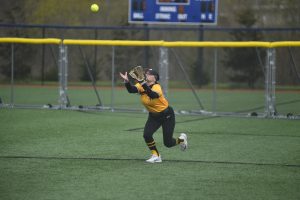10 Neuromechanics of Softball Athletes
Neuromechanics: Softball
Ciera Pyle
Introduction
My name is Ciera Pyle, and I am a graduate student in the Kinesiology Master’s Program at Cal Poly Humboldt. As both a softball alumna and the current graduate assistant coach for the team, I’ve had the opportunity to merge my passion for the sport of softball with my academic pursuits. In this chapter, I focus on how the brain and nervous system influence movement and performance in softball athletes. You’ll gain insight into the ways neuromechanics directly impacts the game, from reaction time and coordination to skill development and injury prevention—and the critical roles that sensory feedback, cortical processing, and motor output play in athletic movement and performance.
Sensory Feedback in Softball
Sensory feedback is a critical component of athletic performance, motor learning, and injury prevention in softball. It refers to the information received by the central nervous system from sensory receptors during and after movement. This feedback is categorized into four main types: proprioceptive, tactile, visual, and auditory. These inputs may be assessed either intrinsically (internally processed by the athlete) or extrinsically (received from the environment or others). In a dynamic sport like softball, sensory feedback guides athletes in adjusting their movements in real time, developing consistent skills, and reducing the risk of injury.
Tactile feedback is particularly vital in optimizing performance. It provides athletes with information through touch and pressure sensations. For instance, while batting, a player can feel the moment the bat makes contact with the ball, immediately interpreting the quality of the hit. Mechanoreceptors in the hands detect vibrations and pressure from the impact, helping the athlete determine whether the contact was solid or off-center (Proske & Gandevia, 78). This feedback allows for real-time correction and is essential in developing consistent, repeatable swing mechanics. Similarly, fielders rely on tactile cues when catching or handling the ball. They may even adjust hand pressure and grip based on whether the ball is wet, further emphasizing how tactile feedback shapes their decision-making and movement.
Visual feedback also plays a fundamental role in softball performance. Athletes continuously process visual information such as pitch speed, spin, trajectory, and the positioning or movement of other players. The visual system relays this information to the brain, which coordinates the motor response accordingly (Abernethy, 109). Batters, for example, rely on visual cues like a pitcher’s arm angle or release point to anticipate the type and location of a pitch. Fielders track the ball visually—whether in the air or on the ground—to position themselves accurately. Improving visual tracking ability through training can significantly enhance an athlete’s timing and overall performance.

Auditory feedback further enhances decision-making and motor response. The sound of the ball making contact with the bat or glove serves as an external cue that complements both tactile and visual input. In addition to environmental sounds, verbal communication among teammates and coaches is critical. Clear communication helps coordinate plays, prevent collisions, and facilitate split-second decisions. Research indicates that athletes react more quickly to multisensory stimuli, meaning auditory cues—when combined with visual and tactile feedback—can improve reaction time and motor output (Zemke et al., 204).
Proprioceptive feedback, or the body’s internal sense of position and movement, allows athletes to execute complex motor skills without needing constant visual confirmation. This is particularly important for softball players who must repeat high-precision motions, such as pitching and batting. Proprioception enables them to develop proper mechanics and motor patterns through repetition. Enhancing proprioception through balance training and neuromuscular conditioning not only improves coordination but also helps prevent injury by strengthening the body’s control systems (Lephart et al., 26).


In conclusion, sensory feedback is foundational to softball performance. Each sensory system—tactile, visual, auditory, and proprioceptive—delivers critical real-time information that supports athletic decision-making, skill development, and injury prevention. Together, these feedback systems shape an athlete’s ability to perform under pressure, adapt to changing environments, and refine movement through practice. A deeper understanding and targeted training of these systems can significantly enhance a softball player’s performance and long-term athletic development.
Cortical Processing in Softball
Cortical processing plays a central role in an athlete’s ability to make rapid decisions and execute precise motor control—particularly fine motor skills. In the context of softball, cortical processing allows athletes to interpret and integrate visual, auditory, and proprioceptive feedback to meet the fast-paced demands of the sport. These processes are essential for both developing technical consistency and maximizing on-field performance.
The motor cortex, a key region of the brain, is responsible for initiating and coordinating voluntary muscle activity. It is one of the primary cortical areas engaged during softball performance. Complex movements such as pitching, fielding, and batting require high levels of coordination and are supported by the motor cortex’s ability to integrate sensory input and translate it into refined motor plans. Additionally, the somatosensory cortex, located adjacent to the motor cortex, provides proprioceptive feedback—information about the body’s position in space—which supports movement precision during both training and competition.
In addition to motor-related areas, the visual cortex plays a critical role in softball performance. Athletes depend heavily on visual input to guide actions such as tracking the ball to make contact with the bat, gauging the ball’s trajectory for a catch, and reading the body language or behavior of opponents. This visual information is processed in the occipital lobe and interpreted in conjunction with spatial processing regions in the parietal lobe, enhancing an athlete’s spatial awareness and timing (Mann et al., 2007). Superior visual processing skills are directly linked to improved reaction time, giving players a competitive edge on both offense and defense.
Equally important is the prefrontal cortex, which governs executive functions such as decision-making, attention, and cognitive flexibility. In a sport like softball, where decisions must often be made in fractions of a second, this brain region is heavily engaged. Whether adjusting a swing mid-motion, redirecting a throw, or shifting tactics during a play, players experience high cognitive load in real-time scenarios. Research shows that elite athletes demonstrate more efficient activation of prefrontal regions involved in working memory and executive control (Nakagawa et al., 2015). This efficiency supports better decision-making and adaptability under pressure.

Taken together, these cortical areas collaborate to interpret sensory input, generate motor commands, and support cognitive processes critical to gameplay. Studies using neuro-imaging techniques such as fMRI have demonstrated that elite athletes activate specific cortical networks more effectively than non-athletes, suggesting that experience and training can enhance the brain’s functional capacity for performance (Yarrow et al., 2009).

Cortical processing is fundamental to success in softball. It underpins an athlete’s ability to process visual, tactile, auditory, and proprioceptive feedback and transform that information into effective movement and decision-making. The motor cortex supports movement execution, the visual cortex aids perception and timing, and the prefrontal cortex governs strategic decisions and attention. A deeper understanding of these neurological functions offers valuable insights for optimizing training, improving performance, and reducing injury risk in softball athletes.
Motor Output in Softball
Neuromechanics, the integration of neuroscience and biomechanics, explores how the nervous system generates, coordinates, and regulates movement—principles highly applicable to softball. Central to this field is motor output, the process by which the brain sends signals to muscles, resulting in purposeful movement. In softball, motor output is involved in every aspect of performance—from generating power and strength in hitting and fielding to reacting quickly and executing accurate throws. This section explores the critical role of motor output in softball and how the neural and muscular systems work together to carry out skilled movements in both performance and training.
Sensory input—including visual, auditory, tactile, proprioceptive, vestibular, and other modalities—is a key driver of motor output. Among these, proprioception plays a particularly significant role. It refers to the body’s ability to sense position, movement, and spatial orientation. For example, when swinging a bat, a softball player uses proprioceptive feedback to fine-tune the swing mechanics, allowing the body to coordinate muscular activity and produce a fluid, controlled motion. Visual input is also critical: both pitchers and catchers use it defensively, while batters rely on it offensively. Each role involves rapid visual recognition followed by specific motor responses—pitching, catching, or hitting the ball.
Proprioceptive and visual information are processed in various brain regions, including the motor cortex, premotor cortex, and cerebellum. These regions work together to develop a “motor plan”—a structured sequence of movements based on prior experience, sensory input, and the body’s reflexive responses (Latash, 121). Once this plan is formed, the brain transmits it through neural pathways, converting it into coordinated physical action.
Motor output is initiated through descending pathways such as the corticospinal tract. Movement signals begin in the primary motor cortex, travel down the spinal cord, and activate motor neurons that engage specific muscle fibers. For instance, in executing a softball swing, the brain activates motor units in a precise sequence: ground force is generated through the legs, the core muscles stabilize the trunk, the torso rotates, and finally, the shoulder, arm, and wrist muscles engage to complete the swing. These movements must be tightly synchronized to ensure proper timing, direction of force, and balance. Throughout the movement, feedback from muscle spindles and joint receptors allows for real-time adjustments, optimizing performance during training or competition (Enoka, 201).
Motor unit recruitment is another essential component of motor output. In softball, different movements require the activation of motor units of varying sizes. For example, when a pitcher throws, small motor units are recruited first for fine control and precision, followed by the activation of larger motor units that generate greater force. This hierarchical activation allows for efficient and effective movement. Deep stabilizer muscles must be activated before larger muscles, such as the deltoids and triceps, to maintain control and reduce the risk of injury. Rate coding, or the frequency at which motor neurons fire, determines the force and explosiveness of muscle contractions (Behm, 375). Disruptions in this neuromuscular communication can compromise performance and increase the risk of injury.

Training plays a critical role in enhancing motor output. Repetitive practice of softball-specific drills strengthens the neural pathways responsible for movement execution. Over time, these pathways become more efficient, resulting in faster and more accurate muscle activation. This neural adaptation improves an athlete’s ability to combine movements fluidly and respond adaptively to the dynamic demands of the game (Behm, 379). Incorporating game-like scenarios into training enhances the athlete’s ability to develop adaptive motor responses, which are essential for reacting to unpredictable in-game situations. As neural communication improves, athletes also build “muscle memory," allowing them to execute complex movements with speed and precision while conserving cognitive effort.
In conclusion, motor output in softball is far more than just movement—it is the result of an intricate, highly coordinated process involving sensory perception, brain function, and muscular activation. Through neuromechanics, we can better understand how motor commands are processed and executed in real time, enabling athletes to perform with precision, power, and adaptability. A deeper understanding of motor output can inform training strategies, reduce injury risk, and help softball players reach their full performance potential in both practice and competition.
References
Abernethy, Bruce. Vision and Sport. Taylor & Francis, 2001.
Behm, David G., and D.G. Sale. “Velocity Specificity of Resistance Training.” Sports Medicine, vol. 15, no. 6, 1993, pp. 374–388. PubMed, PubMed.
Enoka, Roger M. Neuromechanics of Human Movement. 5th ed., Human Kinetics, 2015.
Latash, Mark L. Neurophysiological Basis of Movement. 2nd ed., Human Kinetics, 2008.
Lephart, Scott M., et al. Proprioception and Neuromuscular Control in Joint Stability. Human Kinetics, 2000.
Mann, D. T. Y., et al. “Perceptual-Cognitive Expertise in Sport: A Meta-Analysis.” Journal of Sport and Exercise Psychology, vol. 29, no. 4, 2007, pp. 457–478. PubMed, PubMed.
Nakagawa, K., et al. “Neural Substrates of Baseball Pitch Anticipation: An fMRI Study.” Neuroscience Research, vol. 98, 2015, pp. 39–47. PubMed, PubMed.
Proske, Uwe, and Simon C. Gandevia. “The Proprioceptive Senses: Their Roles in Signaling Body Shape, Body Position and Movement, and Muscle Force.” Physiological Reviews, vol. 92, no. 4, 2012, pp. 1651–1697. PubMed, PubMed.
Yarrow, K., et al. “Inside the Brain of an Elite Athlete: The Neural Processes That Support High Achievement in Sports.” Nature Reviews Neuroscience, vol. 10, no. 8, 2009, pp. 585–596. PubMed, PubMed.
Zemke, Andrew C., et al. “Sensory Integration and Multisensory Processing in Athletic Performance.” Journal of Sports Science and Medicine, vol. 12, 2013, pp. 203–210. PubMed, PubMed.
visual, vestibular, or somatosensory feedback
Includes the brain and spinal cord, which work together to process and integrate sensory information and generate appropriate motor commands.
Proprioceptive feedback is the sensory information received from within the body that helps a person sense the position, movement, and force of their muscles and joints. This feedback comes from proprioceptors—specialized sensory receptors located in muscles, tendons, and joints—that continuously send signals to the brain about body orientation and movement.
Tactile feedback refers to the sensory information received through the skin, particularly from touch and pressure receptors, that helps an individual perceive and adjust their movements. This type of feedback allows the body to sense physical contact with objects, surfaces, or other body parts during activities and provides information about force, texture, and movement.
Visual feedback refers to the sensory information received through the sense of sight that helps an individual monitor and adjust their movements based on what they see in their environment. This feedback is crucial for making real-time adjustments to actions, guiding motor responses, and improving accuracy.
Auditory feedback refers to information received through the sense of hearing that helps an individual monitor, adjust, and improve their actions or performance. In the context of movement or motor learning, auditory feedback involves sounds, such as verbal cues, environmental noise, or the sound of one’s movement, that provide real-time information to guide behavior.
Sensory receptors that respond to mechanical pressure or distortion. They are in the skin, muscles, internal organs, and other tissues, and they help detect sensations such as touch, pressure, vibration, stretch, and sound.
Cortical processing refers to the brain’s ability to interpret, integrate, and respond to sensory and motor information through the activity of the cerebral cortex—the outer layer of the brain responsible for higher-order functions like perception, decision-making, voluntary movement, and cognitive control.
Motor cortex refers to the region of the brain’s cerebral cortex that is primarily responsible for the planning, control, and execution of voluntary movements. It is located in the frontal lobe, specifically in the pre-central gyrus, just in front of the central sulcus.
The primary cortical areas are specialized regions of the brain's cerebral cortex responsible for processing specific types of sensory and motor information. Each primary area is associated with a particular sense or function and serves as the brain’s initial site of input or output for that system.
The Four Major Primary Cortical Areas:
1. Primary Motor Cortex (M1)
Location: Precentral gyrus, frontal lobe
Function: Controls voluntary muscle movements by sending signals to the muscles.
Example: Initiating a softball pitch or swing.
2. Primary Somatosensory Cortex (S1)
Location: Postcentral gyrus, parietal lobe
Function: Processes tactile and proprioceptive information like touch, pressure, and body position.
Example: Feeling the ball in your glove or sensing limb position during a throw.
3. Primary Visual Cortex (V1)
Location: Occipital lobe
Function: Processes visual input from the eyes.
Example: Tracking a softball as it's pitched.
4. Primary Auditory Cortex (A1)
Location: Superior temporal gyrus, temporal lobe
Function: Interprets sounds such as speech, environmental noise, or the crack of a bat.
Example: Reacting to the sound of the ball being hit.
Somatosensory cortex refers to a region of the brain located in the parietal lobe (specifically along the post central gyrus) that is responsible for processing sensory information from the body. This includes sensations such as touch, pressure, temperature, pain, and proprioception (sense of body position and movement).
Visual cortex refers to the part of the brain located in the occipital lobe that is responsible for processing visual information received from the eyes. It is essential for interpreting aspects of vision such as shape, color, motion, depth, and spatial orientation.
The occipital lobe is the rearmost region of the cerebral cortex, located at the back of the brain. Its primary function is to process visual information received from the eyes, making it essential for how we perceive and interpret the visual world.
The parietal lobe is one of the four main lobes of the brain, located near the top and back of the cerebral cortex, just behind the frontal lobe. It plays a central role in processing sensory information, particularly related to touch, spatial awareness, and body position.
Reaction time is the amount of time it takes for a person to respond to a stimulus. It is a key measure of how quickly the brain can process sensory information (such as visual, auditory, or tactile input) and initiate an appropriate motor response.
The prefrontal cortex refers to the frontmost part of the frontal lobe of the brain, and it is primarily responsible for higher-level cognitive functions such as decision-making, attention, problem-solving, planning, impulse control, and working memory.
Functional magnetic resonance imaging, or FMRI, works by detecting the changes in blood oxygenation and flow that occur in response to neural activity.
Neuromechanics is the interdisciplinary study of how the nervous system and musculoskeletal system work together to produce and control movement. It combines principles from neuroscience, biomechanics, motor control, and physiology to understand how the brain, spinal cord, nerves, muscles, and joints interact during physical activity.
The corticospinal tract is a major pathway in the central nervous system that transmits motor signals from the motor cortex in the brain to the spinal cord, facilitating voluntary movement. It is primarily responsible for controlling fine motor skills and the precision of movements, particularly in the limbs.
Muscle fibers are the individual cells that make up muscle tissue. These long, cylindrical cells are responsible for contracting and generating force in muscles, enabling movement. Each muscle fiber is capable of contracting and relaxing in response to signals from the nervous system.
Motor unit recruitment refers to the process by which the nervous system activates a specific number of motor units to generate muscle contraction. A motor unit consists of a motor neuron and the muscle fibers it controls. The recruitment process involves the activation of additional motor units to produce more force as needed for a specific movement or task.
Neural pathways are networks of interconnected neurons that transmit electrical signals throughout the nervous system. These pathways allow for communication between different parts of the brain, spinal cord, and muscles, facilitating the coordination of various functions, including sensory processing, movement, and cognition.
Muscle memory refers to the process by which the body is able to perform specific motor tasks with little conscious effort due to repeated practice. It involves the neural adaptations that occur in the brain and nervous system, enabling faster and more efficient execution of movements.
Muscular activation refers to the process by which the nervous system stimulates muscle fibers to contract and produce force. It involves the recruitment of motor units (motor neurons and the muscle fibers they control) and the transmission of electrical signals to the muscles, triggering them to contract and produce movement.